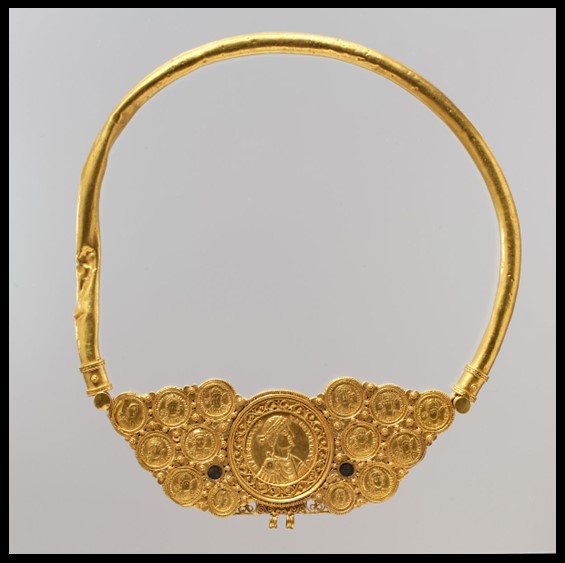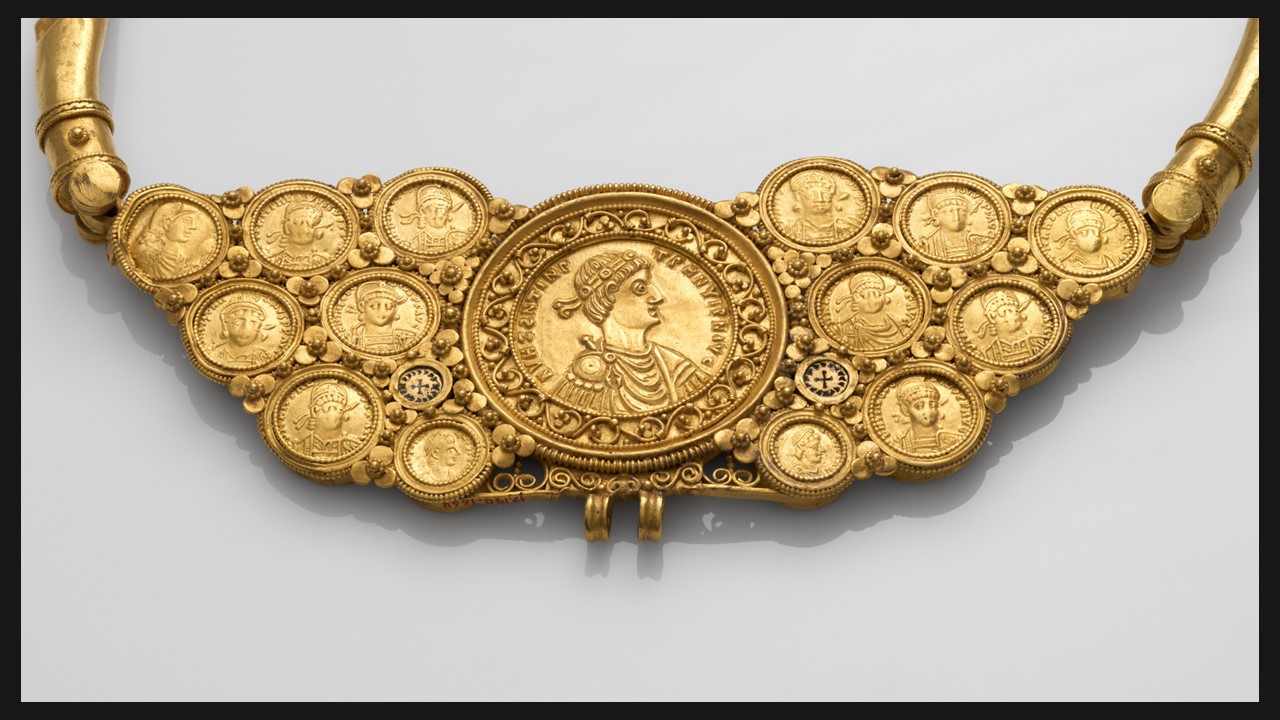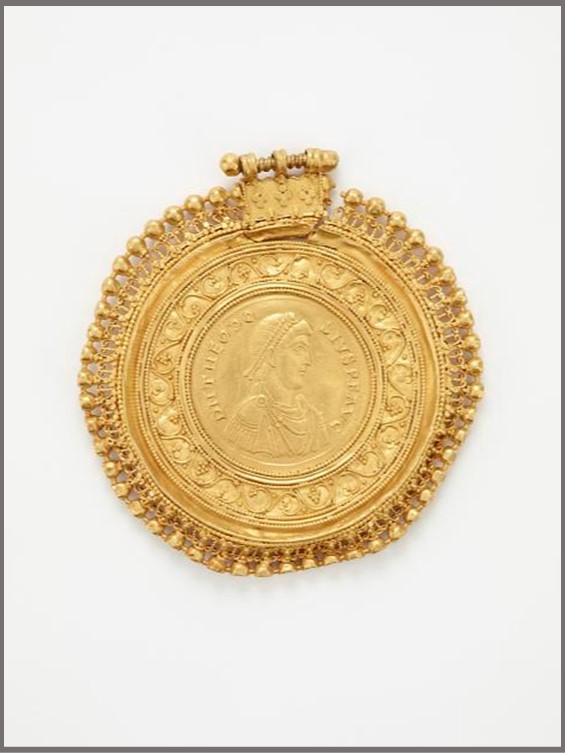
Neck rings, such as the imposing gold Pectoral with Coins and Pseudo-Medallion in the Metropolitan Museum in New York City, are cited in early sources as playing a role both in the glorification of military heroes and in coronation ceremonies. They were popular during the Late Roman period and continued well into the Early Byzantine era. Also known as Byzantine Imperial Collars or Byzantine Imperial Torcs, ornate necklaces like the MET example, were worn by members of the Byzantine imperial family and high-ranking officials during the Byzantine Empire (330-1453 AD). These neck rings were made of gold and decorated with medallions, coins, and intricate designs, often featuring Christian symbols. https://www.metmuseum.org/art/collection/search/464070
The Metropolitan Museum pectoral necklace is composed of a plain, hollow neck ring attached to a frame set with a large central medallion flanked by coins, and two small decorative disks. The central medallion, encased by beaded wire, presents an unidentified Emperor in military attire on the obverse, and the enthroned personification of Constantinople on the reverse. Fourteen coins of Byzantine Emperors reigning during the fifth to the sixth centuries, are placed symmetrically, left, and right of the central medallion. The coins are surrounded by beaded wire as well. Crosses in niello, an interesting reference to Christianity, decorate the two small disks on either side of the medallion. The space between the coins and the medallion is filled with small rosettes and larger trefoils. The two ribbed rings at the pectoral’s lower edge once held a large medallion of the emperor Theodosius I (in the Collection of the Freer Gallery of Art). https://www.metmuseum.org/art/collection/search/464070 and https://www.metmuseum.org/art/metpublications/Age_of_Spirituality_Late_Antique_and_Early_Christian_Art_Third_to_Seventh_Century Age of Spirituality: Late Antique and Early Christian Art, page 318-319


This amazing necklace was part of a hoard of thirty-four pieces of gold jewelry said to have been found at the turn of the twentieth century, possibly at ancient Lycopolis (modern Assiut) or Antinoöpolis (modern Sheikh Ibada), both in central Egypt. The circumstances of the hoard’s discovery remain obscure as the treasure was illegally excavated. The high quality of each piece links the treasure jewels to the imperial workshops in Constantinople. The hoard is now divided among the Metropolitan Museum; the British Museum, London; the Freer Gallery of Art, Washington, D.C.; and the Staatliche Museen-Preussischer Kulturbesitz, Berlin. Whether the pieces were indeed discovered together or were assembled from different sites, they represent the standard of luxury among the elite in Egypt under Byzantine rule and attest to the close connection between the wealthy province and the capital Constantinople. https://www.metmuseum.org/art/metpublications/The_Arts_of_Byzantium_The_Metropolitan_Museum_of_Art_Bulletin_v_58_no_4_Spring_2001 “The Arts of Byzantium”: The Metropolitan Museum of Art Bulletin, v. 58, no. 4 (Spring, 2001), Page 19 and “Into the hands of a well-known antiquary of Cairo”: The Assiut Treasure and the Making of an Archaeological Hoard by Elizabeth Dospěl Williams, West 86th: A Journal of Decorative Arts, Design History, and Material Culture, Vol. 21, No. 2 (Fall-Winter 2014), pp. 251-272 https://www.jstor.org/stable/10.1086/679985?read-now=1#page_scan_tab_contents
The Byzantine Imperial Neck Rings were not just a fashion accessory, they were a symbol of power and authority. The imperial family, for example, wore them on important occasions, such as coronations, to demonstrate their wealth and status. Members of the Byzantine military elite, on the other hand, wore them as trophies of their military distinction. According to Procopius, soldiers were rewarded with money, and honoured with precious necklaces or bracelets. It is interesting to note that during the Early Byzantine period, men and women wore such necklaces alike. https://www.metmuseum.org/art/metpublications/Age_of_Spirituality_Late_Antique_and_Early_Christian_Art_Third_to_Seventh_Century Age of Spirituality: Late Antique and Early Christian Art, Third to Seventh Century, edited by Kurt Weitzmann, 1979, page 318-319
For a PowerPoint on the so-called Assiut Treasure, please… Check HERE!